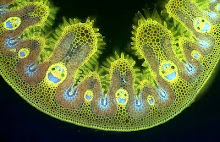Ever since masterwort Astrantia major was introduced into British gardens in 1597, from its native central and eastern Europe, garden writers have been somewhat dismissive of the plant. William Robinson, in The English Flower Garden in 1883 was wary of its invasive tendencies (".... apt to over-run and exhaust the soil") and suggested that "if grown at all it should be in rough or wild places, or in the back part of the shrubbery".
However, the species in the picture above, Astrantia maxima, is rather more delicate and trickier to cultivate, so is unlikely to be invasive. It needs better, more moisture-retentive soil than A. major.
It's easy to see why the more commonly cultivated A. major was sometimes known as 'hattie's pincushion" and why Graham Stuart Thomas, in his Perennial Garden Plants (1976) described the flowers as having "...an interesting and beautiful shape". .
It isn't obvious that this is a member of the Umbelliferae but if you shrink that ring of papery bracts and elongate the pedicels that support the individual florets the result is a more obvious umbel.
The plant has a long flowering period, seems to do well in sun, shade and dry soil in my garden, makes an attractive long-stemmed addition to a bunch of cut flowers and, best of all, is an excellent source of pollen and nectar for .....
... hoverflies ....
..... and bees, that merely need to walk over the inflorescence to collect their reward with minimum effort.

















